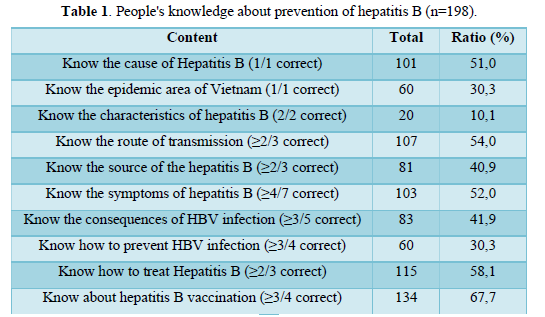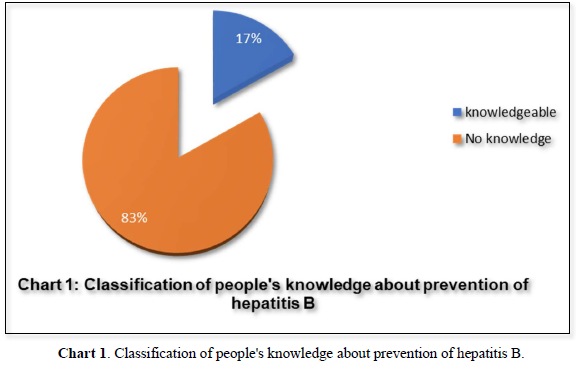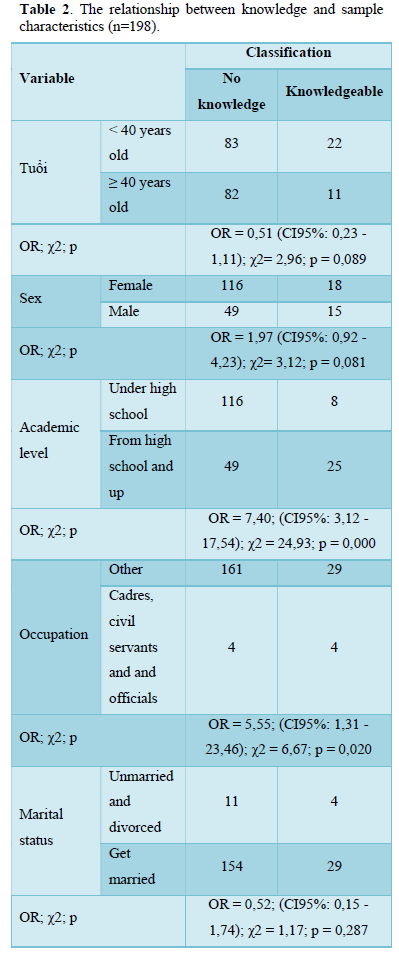Research Article
Status of Knowledge about Prevention of Hepatitis B Among People in Trung Nguyen Commune, Yen Lac District, Vinh Phuc Province in 2018.
4223
Views & Citations3223
Likes & Shares
Objective: Describe the status of knowledge about prevention of hepatitis B and identify some factors related to knowledge about prevention of hepatitis B of people in Trung Nguyen commune, Yen Lac district, Vinh Phuc province in 2018.
Method: A cross-sectional, descriptive study were conducted on 198 people aged 18 years and above in Trung Nguyen Commune, Yen Lac District, Vinh Phuc Province from January 2018 to June 2018.
Results: The rate of people with general knowledge about prevention of hepatitis B was 16.7%. There is a relation between knowledge about prevention of hepatitis B with the level of education and occupation of the people.
Conclusions: The knowledge about prevention of hepatitis B in Trung Nguyen commune, Yen Lac district, Vinh Phuc province were low, with the rate of 16.7%. Need of communication - health education to improve knowledge to prevent hepatitis B for people is very necessary.
Keywords: Hepatitis B, Knowledge, Prevention
INTRODUCTION
Hepatitis B is a dangerous infectious disease caused by the hepatitis B virus (HBV). It is highly infectious [1]. Worldwide, an estimated 350 million people are chronically infected with HBV, about 240 million people are chronically infected with hepatitis B, 1/4 of people with chronic hepatitis B will die from liver cancer or liver failure if they are not monitored and examined regularly [2]. Vietnam is located in an area of high prevalence and suffers severe consequences from HBV infection. Research results show that 1 in 8 people in the community will have hepatitis B and the proportion of patients with chronic liver diseases and liver cancer has been determined to be closely related to the rate of hepatitis B. HBsAg (+), about 40% of liver cancer deaths are related to hepatitis B. The rate of people carrying HBsAg (+) is from 10 to 20%, in some rural areas this rate can be up to 25%. Therefore, hepatitis B has been and is a serious global health problem. Serious diseases, in addition to being highly infectious in the community, but also leave complications and severe consequences. Up to now, there is no specific treatment for the disease, so prevention is very important [3]. It is extremely necessary for people to have knowledge about prevention of hepatitis B to improve the effectiveness of disease prevention [4]. Yen Lac is a plain district, south of Vinh Phuc province. The report of the Preventive Medicine Center of Vinh Phuc province in the first 6 months of 2017, 30.7% of hepatitis B patients residing in Yen Lac district were treated at provincial and district health facilities in the Vinh Phuc province. It accounts for the highest proportion in the districts and cities of the province. In which, people infected with hepatitis B of Trung Nguyen commune accounted for 10.9% of the total number of hepatitis B patients in this district receiving treatment. This requires that we conduct a survey on people's knowledge of hepatitis B prevention in Trung Nguyen commune to identify the limitations in knowledge, thereby having an appropriate health education program to improve people's knowledge. Therefore, we conducted a study on “Status of knowledge about prevention of hepatitis B among people in Trung Nguyen commune, Yen Lac district, Vinh Phuc province in 2018” with the following two specific
objectives.
- Describe the current situation of knowledge about prevention of hepatitis B among people in Trung Nguyen commune, Yen Lac district, Vinh Phuc province in 2018.
- Identify some factors related to knowledge about prevention of hepatitis B among people in Trung Nguyen commune, Yen Lac district, Vinh Phuc province in 2018.
METHODS
Participants: Participants are people in Trung Nguyen commune, Yen Lac district, Vinh Phuc province.
Selection criteria: People selected must meet the following criteria:
- Have resided stably and regularly for 01 year or more in Trung Nguyen commune, Yen Lac district.
- Be 18 years of age or older.
- No cognitive disturbances.
- Able to listen, speak, read and write in Vietnamese.
- Agree to participate in the study.
Exclusion criteria: People do not fill out all the information into the survey.
Time and place of study: The study was carried out from January 2018 to June 2018 in all 09 villages of Trung Nguyen commune, Yen Lac district, Vinh Phuc province.
Time and place of study: The study was carried out from January 2018 to June 2018 in all 09 villages of Trung Nguyen commune, Yen Lac district, Vinh Phuc province.
Study design: Using cross-sectional study to assess people's knowledge about prevention of hepatitis B.
Samples and sampling methods
Sample size
Apply the formula to calculate sample size:


Inside:
n: Minimum sample size.
Z: Confidence coefficient, with 95% confidence, then Z = 1.96.
p: is the percentage of people with correct general knowledge about prevention of hepatitis B. According to research by Nguyen Viet Loc (2011), the percentage of people with correct knowledge about prevention of hepatitis B is 7.44% [5]. So, we choose p = 0.075.
q = (1-p) = 1- 0.075 = 0.925.
d = 0.05 (desired absolute precision).
Applying the formula, we have n = 106. To avoid the risk of error when sampling, the researcher chooses a sample of 1.5 x n = 159 people. In fact, 198 people participated in the study.
Sampling methods: Random sampling in the field, specifically: Trung Nguyen commune has 09 villages. In each village, the village health worker chooses the direction from the house using the left-hand rule. Select the first household to enter and select the research subjects who are present at home that match the selection criteria. In case all subjects in the household refuse to participate in the study or the household If the family is not at home, they will skip it and move on to the next household, according to the "house-to-house" method, choosing until there are 22 people.
The method of data collection
Data were collected by indirect interview method by directly filling in the data collection questionnaire.
Assessment standards
Questionnaire Knowledge about prevention of hepatitis B has 13 questions, including the following sentences: Causes of the disease, endemic areas in Vietnam, characteristics of the disease, transmission route, source of the pathogen, disease manifestations, consequences of HBV infection, treatment and prevention of hepatitis B. with multiple choices in each question. ach question is designed to be multiple choice. Each correct choice gets 1 point and the wrong choice gets 0 point. The maximum total score of general knowledge is 33 points, the minimum score is 0 points. People are assessed as having general knowledge when they get 70% of the maximum total knowledge score (≥ 23 points).
Data analysis
SPSS 16.0 software was used to analyze the data.
General information about Participants, knowledge about prevention of hepatitis B will be analyzed by descriptive statistics including frequency, the rate. Determine the relationship between knowledge and sample characteristics using logistic regression algorithm, Chi-square test.
RESULTS
Characteristics of Participants
Out of a total of 198 people who participated in the study, men accounted for 67.7%, women accounted for 32.3%. Participants were aged from 18 to 73 years old with an average age of 40.84 ± 14.04 years old. Education level includes: lower secondary school (52.5%), high school 22.2%, college and university 10.7%, primary school 10.1%, intermediate level 4.5%. Occupation: Farmer 58.1%, worker 17.2%, trade and service 12.6%, other occupation 5.6%; Cadres, civil servants and and officials 4.0%, craftsman 2,5%. Marital status: Married 92.4%, unmarried 7.1%, people divorced 0.5%. Sources of information about hepatitis B: Television 90.9%; radio station 40.4%; medical staff 31.8%; books and newspapers 12.1%; leaflets 10.1%; community meetings 5.1%; billboards, posters 3.5%; other sources 14.1%.
People's knowledge about prevention of hepatitis B
The results in Table 1 show that the highest rate of people knowing about hepatitis B vaccination is 67.7%, followed by the route of transmission with 54.0%; the lowest rate of people knowing about the characteristics of HBV infection is 10.1% (Table 1).


Classification of people's knowledge about prevention of hepatitis B: People with general knowledge about prevention of hepatitis B account for 16.7%; People with general knowledge about hepatitis B prevention accounted for 16.7% and no knowledge accounted for 83.3% (Chart 1).


Factors related to people's knowledge about prevention of hepatitis
The results of Table 2 show that people with less than high school education have inadequate knowledge about prevention of hepatitis B 7.40 times higher than people with education from high school or higher, this difference is significant. statistics (p < 0.05); Other occupational groups have less knowledge 5.55 times higher than that of cadres, civil servants and officials, this difference is statistically significant (p < 0.05).


DISCUSSION
The results in Table 1 show that people have low knowledge about prevention of hepatitis B, specifically: Disease characteristics, pathogens, consequences of the disease are much lower than research research by Tran Thi Tay Nguyen in 2015 (10.1%, 40.9% and 13.6% compared to 72.1%, 50% and 44.7%) [3]; The transmission route of the disease is 54% similar to the research results of Nguyen Minh Ngoc and Bui Huu Hoang in 2011 (58.5%) [5]; disease symptoms and treatment are similar to the research results of Tran Ngoc Dung and Huynh Thi Kim Yen in 2010 (23.2% and 58.1% compared with 24.1% and 69%) [6]; know how to prevent disease 30.3% similar to the study of Ngo Manh Quan in 2014 (27.7%) [8]; vaccination against hepatitis B 67.7%. People with general knowledge about prevention of hepatitis B have a low rate of only 16.7%. It is lower than a study by Trinh Van Nghinh in 2009 carried out in Yen Vien town, Gia Lam district, Hanoi with the result of 22.1% [9]. This may be due to the fact that people in urban areas have a higher level of education than in rural areas and people have access to many sources of information about prevention of hepatitis B. Another study by Ly Van Xuan in 2009 conducted on patients who came to Binh Phuoc General Hospital also had higher results than our study (29.22% versus 16.70%) [10]. The results of our study are much lower than the study of Tran Ngoc Dung and Huynh Thi Kim Yen in 2010 (52.5%) conducted on the same population but the study location was conducted in urban areas [6]. The research results set out the necessary requirement to improve the people's knowledge about prevention of hepatitis B with health education and communication activities. Research results show that there is a relationship between education level, occupation and knowledge about hepatitis B prevention (p < 0.05) consistent with the research results of Trinh Van Nghinh in 2009 [9]. Analyzing this relationship by education level, people with lower secondary education have knowledge about hepatitis B prevention 7.40 times lower than people with high school education and above, this difference is statistically significant (p < 0.05). This completely reflects the reality; qualified people will care more about their health and often know how to take care and protect their health. On the other hand, people with expertise will quickly grasp and remember long-term media messages about hepatitis B prevention. This issue helps us to know how to use communication content, [11] forms and methods. Other occupational groups have 5.55 times lower knowledge about prevention of hepatitis B than cadres, civil servants and officials. This difference is statistically significant (p < 0.05). This is also appropriate because cadres, civil servants and officials are often highly educated people, so their understanding of hepatitis B prevention. Other occupations often have low educational attainment and have to struggle to make a living, so they do not have time to access information about prevention of hepatitis B.
CONCLUSION
The general knowledge of people to prevent hepatitis B is 16.7%. People's education and occupation are factors related to general knowledge of hepatitis B prevention. Need of communication - health education to improve knowledge about prevention of hepatitis B for people is very necessary.
- Nguyen TH, Nguyen VC (2006) Questions and answers about vaccination against hepatitis B, Medical Publishing House, Hanoi, pp: 1-17.
- Asian Liver Center - Stanford University (2006) A handbook for healthcare professionals on hepatitis B. Avalaible online at: https://med.stanford.edu/liver.html
- Tran TTN (2015) Knowledge, attitude, practice and some related factors in the prevention of hepatitis B virus infection among 2nd year nursing students of Phu Yen Medical College in 2015, Master Thesis of Public Health, University School of Public Health.
- Huynh LND, Phan TTN (2014) Knowledge, attitude and practice about prevention of hepatitis B virus infection of people in Hung Phu ward, Cai Rang district, Can Tho.
- Ngo VL (2011) Study about the situation of hepatitis B virus infection and evaluate the results of intervention solutions in the residential community in Thua Thien Hue province, Doctor of Medicine thesis, Hue University of Medicine and Pharmacy.
- Nguyen MN, Bui HH (2011) Knowledge and adherence of adult patients infected with hepatitis B virus visiting Pasteur Hospital, Ho Chi Minh City. Med J Ho Chi Minh City 15: 291-295.
- Tran ND, Huynh TKY (2010) Study about infection situation and people's knowledge, attitudes and practices on prevention of hepatitis B virus infection in Ninh Kieu district, Can Tho city. J Prac Med 5: 161-166.
- Ngo MQ (2014) Knowledge, attitude and practice in preventing hepatitis B virus infection in blood donors in Hanoi.
- Trinh VN (2009) Knowledge and practice about prevention of hepatitis B among people in Yen Vien town, Gia Lam district, Hanoi city, Master thesis of Public Health, University of Public Health.
- Dong NPU, Le TAT (2010) Knowledge, attitude and practice about prevention of pressure ulcers among nurses in the emergency department, Practical Medicine, Ho Chi Minh City.
- Ly VX, Phan TQT (2009) Knowledge, attitude and practice about hepatitis B prevention among patients who visited Binh Phuoc General Hospital in 2009, Ho Chi Minh City Med J pp: 1-7.
QUICK LINKS
- SUBMIT MANUSCRIPT
- RECOMMEND THE JOURNAL
-
SUBSCRIBE FOR ALERTS
RELATED JOURNALS
- Journal of Cancer Science and Treatment (ISSN:2641-7472)
- International Journal of Diabetes (ISSN: 2644-3031)
- Archive of Obstetrics Gynecology and Reproductive Medicine (ISSN:2640-2297)
- Journal of Allergy Research (ISSN:2642-326X)
- Journal of Neurosurgery Imaging and Techniques (ISSN:2473-1943)
- Journal of Pathology and Toxicology Research
- Journal of Otolaryngology and Neurotology Research(ISSN:2641-6956)



